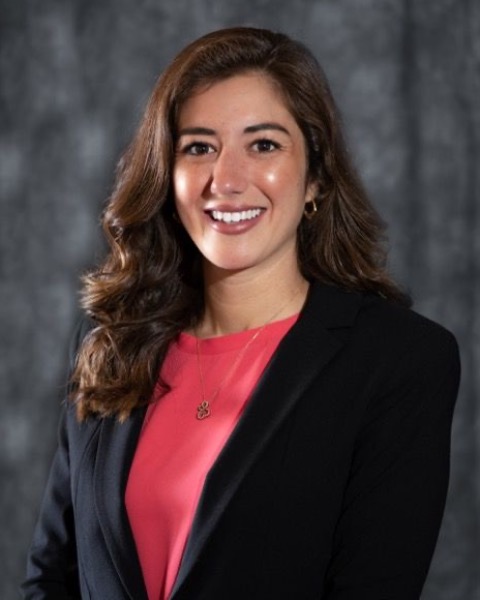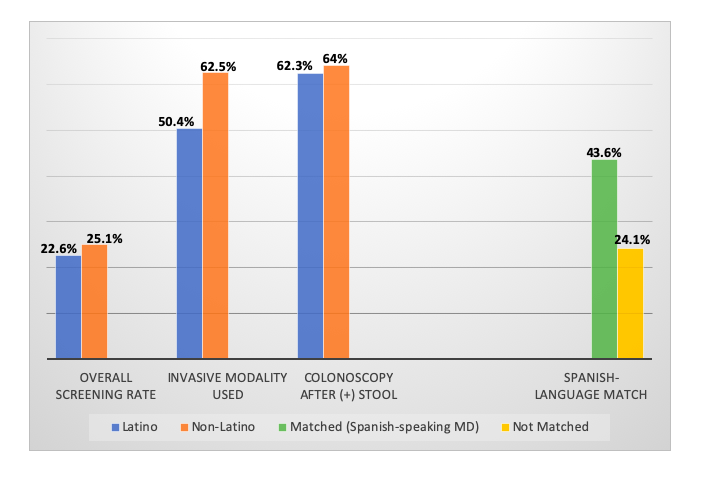Tuesday Poster Session
Category: Colorectal Cancer Prevention
P4786 - Colon Cancer Screening Rates in the Latino Community at a Tertiary Care Center
Tuesday, October 28, 2025
10:30 AM - 4:00 PM PDT
Location: Exhibit Hall

Alejandra Perez-Chapman, DO
Geisinger Health System
Danville, PA
Presenting Author(s)
Alejandra Perez-Chapman, DO, Michael Makar, MD, David L.. Diehl, MD, Lifang Zhang,
Geisinger Health System, Danville, PA
Introduction: Colorectal cancer (CRC) screening improves survival rates by early detection and treatment of precancerous polyps. Little is known about differences in approach to CRC screening between Latino and non-Latino populations. Addressing this knowledge gap may be key in advancing efforts to improve CRC screening rates among the Latino community.
Methods: From 2013 to 2023, 488,786 adults (ages 45-75) were seen at our medical center who were at average risk for CRC, and 122,209 had CRC screening. Among those screened, 3,963 identified as Latino. Screening tests could be invasive (colonoscopy) or noninvasive modalities including colonography and stool tests (Cologuard, fecal immunochemical test, and fecal occult blood test). Medical charts were reviewed to determine how many patients underwent screening, by which modality, and how positive stool tests were investigated. 676 patients were selected from the non-Latino pool for comparison by matching patients’ age and sex. To explore the impact of language barriers on screening rates, we also identified Latino patients whose preferred language was Spanish.
Results: Among the patients at average risk for CRC, 22.56% of Latino patients had initial screening as compared to 25.09% of non-Latino patients (odds ratio 0.87 and 0.84, p = 0.0001). Of the patients who had screening, 50.39% of Latino patients used invasive screening methods as compared to 62.53% of non-Latino patients (odds ratio 0.61 and 0.57, p = 0.0001). We identified 990 patients with a positive stool test, 338 of whom were Latino. 62.28% of Latino patients were compliant with follow-up colonoscopy, compared to 64.02% of non-Latino patients (p = 0.589). From the entire Latino population at our medical center at average risk for CRC between 2013 and 2023, 7,688 patients preferred Spanish as their primary language. Among the Latino patients matched with Spanish-speaking physicians, 43.59% had screening, compared to 24.09% among the patients who were not matched (OR 2.44, p= 0.0001).
Discussion: Of patients at average risk for CRC, there is a lower overall screening rate in the Latino population. Language barriers between patient and physician may account for some of this difference as almost twice as many Latino patients had screening if their physicians were Spanish-speaking. Latinos commonly used non-invasive initial screening methods. There was no difference between Latinos and non-Latinos in the use of colonoscopy to investigate a positive stool test.

Figure: Table 1: Screening Outcomes
Table 2: Language Match Analysis

Figure: Colorectal Screening Rates
Disclosures:
Alejandra Perez-Chapman indicated no relevant financial relationships.
Michael Makar indicated no relevant financial relationships.
David Diehl indicated no relevant financial relationships.
Lifang Zhang indicated no relevant financial relationships.
Alejandra Perez-Chapman, DO, Michael Makar, MD, David L.. Diehl, MD, Lifang Zhang, . P4786 - Colon Cancer Screening Rates in the Latino Community at a Tertiary Care Center, ACG 2025 Annual Scientific Meeting Abstracts. Phoenix, AZ: American College of Gastroenterology.
Geisinger Health System, Danville, PA
Introduction: Colorectal cancer (CRC) screening improves survival rates by early detection and treatment of precancerous polyps. Little is known about differences in approach to CRC screening between Latino and non-Latino populations. Addressing this knowledge gap may be key in advancing efforts to improve CRC screening rates among the Latino community.
Methods: From 2013 to 2023, 488,786 adults (ages 45-75) were seen at our medical center who were at average risk for CRC, and 122,209 had CRC screening. Among those screened, 3,963 identified as Latino. Screening tests could be invasive (colonoscopy) or noninvasive modalities including colonography and stool tests (Cologuard, fecal immunochemical test, and fecal occult blood test). Medical charts were reviewed to determine how many patients underwent screening, by which modality, and how positive stool tests were investigated. 676 patients were selected from the non-Latino pool for comparison by matching patients’ age and sex. To explore the impact of language barriers on screening rates, we also identified Latino patients whose preferred language was Spanish.
Results: Among the patients at average risk for CRC, 22.56% of Latino patients had initial screening as compared to 25.09% of non-Latino patients (odds ratio 0.87 and 0.84, p = 0.0001). Of the patients who had screening, 50.39% of Latino patients used invasive screening methods as compared to 62.53% of non-Latino patients (odds ratio 0.61 and 0.57, p = 0.0001). We identified 990 patients with a positive stool test, 338 of whom were Latino. 62.28% of Latino patients were compliant with follow-up colonoscopy, compared to 64.02% of non-Latino patients (p = 0.589). From the entire Latino population at our medical center at average risk for CRC between 2013 and 2023, 7,688 patients preferred Spanish as their primary language. Among the Latino patients matched with Spanish-speaking physicians, 43.59% had screening, compared to 24.09% among the patients who were not matched (OR 2.44, p= 0.0001).
Discussion: Of patients at average risk for CRC, there is a lower overall screening rate in the Latino population. Language barriers between patient and physician may account for some of this difference as almost twice as many Latino patients had screening if their physicians were Spanish-speaking. Latinos commonly used non-invasive initial screening methods. There was no difference between Latinos and non-Latinos in the use of colonoscopy to investigate a positive stool test.

Figure: Table 1: Screening Outcomes
Table 2: Language Match Analysis

Figure: Colorectal Screening Rates
Disclosures:
Alejandra Perez-Chapman indicated no relevant financial relationships.
Michael Makar indicated no relevant financial relationships.
David Diehl indicated no relevant financial relationships.
Lifang Zhang indicated no relevant financial relationships.
Alejandra Perez-Chapman, DO, Michael Makar, MD, David L.. Diehl, MD, Lifang Zhang, . P4786 - Colon Cancer Screening Rates in the Latino Community at a Tertiary Care Center, ACG 2025 Annual Scientific Meeting Abstracts. Phoenix, AZ: American College of Gastroenterology.
